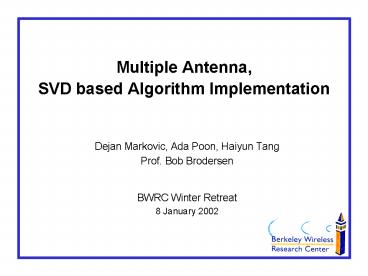Multiple Antenna, SVD based Algorithm Implementation - PowerPoint PPT Presentation
1 / 20
Title:
Multiple Antenna, SVD based Algorithm Implementation
Description:
SVD based Algorithm Implementation. Dejan Markovic, Ada Poon, Haiyun Tang. Prof. Bob Brodersen ... Linear time-varying filter with impulse response h(t) ... – PowerPoint PPT presentation
Number of Views:28
Avg rating:3.0/5.0
Title: Multiple Antenna, SVD based Algorithm Implementation
1
Multiple Antenna, SVD based Algorithm
Implementation
- Dejan Markovic, Ada Poon, Haiyun Tang
- Prof. Bob Brodersen
- BWRC Winter Retreat
- 8 January 2002
2
MIMO Capacity Gain
MIMO
Rx diversity
1 Tx, 1 Rx antenna case
3
Wireless Channel Characterization
Linear time-varying filter with impulse response
h(t)
Sum of discrete rays with different amplitude and
random phases
Narrowband scenario ? ltlt Tsymbol Central Limit
Theorem
R Rayleigh ? Unif 0, 2?
Complex 1-tap narrowband flat Rayleigh channel
4
Time-varying Multi-path Channel
1kHz Doppler 4 multi-paths 16 carriers
5
MIMO Channel Model
Tx
Rx
6
Concept of SVD
BB-equivalent channel models
y H x z
1.
y U ? V x z
SVD
2.
x' V x y' U y z' U z
y' ? x' z'
Unitary X-form
3.
Need to know V at Tx and U,? at Rx
7
System Perspective
8
Model of SVD based Tx-Rx
- LMS based blind tracking of SVD components U,?,V
- U?,V updated every symbol period
- Periodic feedback every few hundred data symbols
- Additional blocks required at the Rx side for
blind tracking
9
Simulink Simulation Model
10
Architecture V Matrix
11
Architecture U? Matrix
12
Tracking Performance
tracked
ideal
Optimal step size
Weak subchannel
13
Implementation Tracking V Matrix
Tracking Algorithm for V
?i ? R1?1 x, vi ? C4?1 yi ? C1?1
Algorithm Implementation (MC/SSHAFT)
vi(n1) vi(n) ?i ( yi(n1) vi(n)
x(n1) ) x(n1)
14
Implementation Tracking U? Matrix
Tracking Algorithm for U,?
Receive y(n1)
r y(n1)
for i14
wi(n1) wi(n) ?i (r r wi(n) ?i(n)
w(n))
?i ? R1?1 y, wi ? C4?1 ?i ? R1?1
?i (n1) wi(n1) wi(n1)
exit at i4
r r - (wi(n1) r) wi(n1) / ?i (n1)
C1?1
C4?1
end for
Algorithm Implementation (MC/SSHAFT)
15
Hardware Parameters (0.25mm)
Module Compiler based estimates _at_ fCLK100MHz
Building Blocks
inputs
output
P mW
A mm2
D ns
N
1.
5.9
0.156
7.7
C4?1 , C4?1
C1?1
Cmult_Vd_V
8
2.
0.4
0.075
2.1
C1?1 , C1?1
C1?1
Csub_d
8
3.
5.6
0.158
6.9
C1?1 , C4?1
C4?1
Cmult_S_V
8
4.
2.2
0.064
7.2
R1?1 , C4?1
C4?1
Cmult_RS_V
8
5.
1.2
0.027
2.0
C4?1 , C4?1
C4?1
Csum_V_V
8
6.
20.1
0.459
12.3
C4?1 , R1?1
C4?1
Cdiv_V_RS
8
Summary of the overall SVD hardware
characteristics
SVD
inputs
output
P mW
A mm2
D ns
N
64
1.74
8.2
R1?1 ,C4?1 , C4?1
C4?1
V_est
8
R1?1 , C4?1
U?_est
8
R4?4 , C4?1
8.2
210
5.54
16
SVD Based OFDM System
(A. Klein 00)
need 48 SVD blocks!
17
SSHAFT Synthesis of V Matrix
- 0.18mm process
90 dense
V(1)
0.47mm
0.47mm
18
Overall OFDM System Parameters
Module Compiler, fCLK 20MHz
19
Breakdown of SVD-OFDM Chip Area
0.25mm
SVD
20
Porting to a New Technology
4x4 OFDM system is feasible































